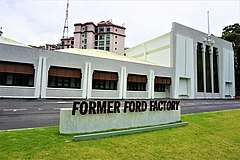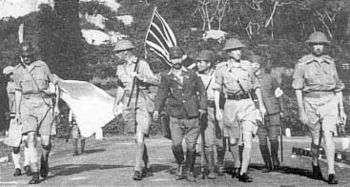Former Ford Factory
The Former Ford Factory (also Old Ford Motor Factory and Old Ford Factory depending on sources) is located along Upper Bukit Timah Road at Bukit Timah in Singapore. It is the place where British forces under Lieutenant-General Arthur Percival surrendered to Japanese forces under Lieutenant-General Yamashita Tomoyuki on 15 February 1942 after the Battle of Singapore. The Old Ford Motor Factory had since been gazetted as a National Monument in 2006, and converted into an exhibition gallery and archive named Memories at Old Ford Factory.
| Former Ford Factory | |
|---|---|
 | |
.svg.png) | |
| Alternative names | Old Ford Factory Old Ford Motor Factory Temporarily named as "Syonan Gallery" |
| General information | |
| Architectural style | Art Deco |
| Location | Bukit Timah, Singapore |
| Address | 351 Upper Bukit Timah Road, Singapore 588192 |
| Country | Singapore |
| Coordinates | |
| Named for | Ford |
| Opened | October 1941 |
| Owner | Ford Motor Company of Malaya (former) National Archives of Singapore |
| Affiliation | National Heritage Board |
| Design and construction | |
| Architect | Emile Brizay |
| Known for | a venue in Singapore where the British officially surrendered Singapore to the Japanese during World War II in 15 February 1942 |
| Designated | 15 February 2006 |
History
The factory was established and built for the Ford Motor Company of Malaya (also known as Ford Malaya in short) in October 1941 and possessed an Art Deco-style façade, which was typical of most buildings and structures, both public and private, of that era, and became Ford's first motor-car and vehicle assembly and construction plant in the region of Southeast Asia.[1]
However, Japanese military forces invaded Singapore shortly thereafter. During the Malayan Campaign starting from December 1941, the factory's modern and state-of-the-art assembly equipment was taken over and used by the British Royal Air Force (RAF) to assemble fighter aircraft for defending Allied air forces in the region, aside from the RAF. The fighter planes, most of which were of American origin (such as the Brewster Buffalo), came in individual break-down parts that were shipped to Singapore in large wooden crates. However, most of the aircraft constructed at the factory never fulfilled their intended purpose of defending British Malaya as well as their main stronghold of Singapore. They were all gradually flown out of Singapore towards the end of January 1942 when the prospects for Singapore's defence against the Japanese military's conquest looked bleak and grim. Many battles and skirmishes were fought between British forces and Japanese troops around the areas of the Ford Motor Factory in Bukit Panjang, Choa Chu Kang, Hillview, Bukit Batok and Bukit Timah.

The factory was subsequently captured and taken over by the Imperial Japanese Army (IJA) and used as its military headquarters for commanding of all of its forces in both the recently captured Malaya as well as Singapore. Following the British military surrender of Singapore on 15 February in that same year, IJA forces relocated its headquarters from the motor plant to Raffles College along Bukit Timah Road.
During the Japanese occupation of Singapore from 1942 to 1945, the factory was designated as a butai, or a Japanese-run facility. Nissan, which was then a prominent zaibatsu, or a vertically-integrated monopoly, took over the entire plant to assemble trucks and other motor vehicles for the Japanese military based in Malaya and Singapore as well as abroad elsewhere, such as in its various occupied territories in the Asia-Pacific region.
The Ford Motor Factory returned to the Ford corporation following the Japanese surrender in August 1945. Normal business operations under Ford was resumed in 1947. Between 1947 and 1980, the plant continued to produce cars and vehicles, including parts and equipment (such as tyres and engine components) for the local as well as regional markets. Ford Motor Factory finally closed its doors permanently and shut down in June 1980 and was left abandoned for some time afterwards.
During the time of the factory's abandonment, several horror stories regarding the old factory began circulating amongst the local population, mostly centred on the periods of the end of British colonial rule over the island in February 1942 and the subsequent Japanese occupation of Singapore and its final end in 1945. Such paranormal tales of the former motor plant include the presence of ghosts of former Japanese personnel and troops once stationed at the motor plant, some of whom also committed suicide at the factory following their country's surrender at the end of WWII, and the sightings and sounds of supernatural activities at the locked-up premises, such as the supposed hearing of old Japanese music and songs dating back to the decades of the 1930s and the 1940s and alleged sightings of restless (perhaps sometimes even hostile and malevolent) spirits roaming around the old factory's buildings.
On 7 February in 2006, the Preservation of Monuments Board announced that it would gazette the historic factory for preservation as a National Monument on the 64th anniversary of the British surrender of Singapore and its subsequent fall to Imperial Japan on 15 February 1942.[2][3][4]
Exhibition gallery
The National Archives of Singapore, the new custodian of the historical site, has converted the building to house an exhibition gallery and repository called Memories at Old Ford Factory. The preserved Old Ford Motor Factory underwent a two-year, S$10.3 million facelift and is now the National Archives's second repository for its growing archives of various media. The permanent exhibition gallery showcases life in Singapore under Japanese rule, and the exhibition is a continuation from the one on the last battles fought at Pasir Panjang.
The original factory building was very deep but much of it has been removed leaving the front facade and a building of moderate depth. Careful restoration work had been undertaken for the building to ensure that its façade was restored as close as possible to the building's original facade when it was first completed in 1941. The boardroom where the surrender took place remains intact and is preserved. It contains a replica of the original table (with the original currently with the Australian War Memorial), a clock set at the exact time of the surrender, and a map of Malaya. There is now a large modern structure at the street level south of the factory building where visitors can enter and have a walk either up the hill or through this building to the factory.
The journey through the exhibition begins at a reconstructed tunnel, which documents the events leading to the fall of Singapore. Newspaper clips, maps and historical artefacts line the walls, ceiling and floor of the tunnel. At the same time, new facilities such as an audio-visual theatre, with a seating capacity for 76 people, are also integrated into the refurbishment. The theatre screens specially commissioned documentaries, highlighting different aspects of life in Syonan-to – the name given to Singapore during the Japanese occupation. The garden plot behind the gallery features wartime crops like tapioca, sugar cane and bananas with a wooden walkway similar to that found during the period as well as explanations of the plants.
Behind the museum are tall condominium buildings and a transmission tower. The front of the museum features a Chinese calligraphic sculpture called He Ping (和平, "peace" in Chinese), storyboards recounting the battles fought during the Malayan Campaign and the history of Bukit Timah, as well as a granite rock carved with a statement from a decree by Tang dynasty Emperor Taizong urging visitors to "take history as a lesson".
Memories at Old Ford Factory
Memories at Old Ford Factory (Chinese: 旧福特车厂纪念馆; Malay: Kenangan di Kilang Ford Lama) was officially opened by Singapore's Defence Minister Teo Chee Hean on 16 February 2006. The museum had free admission during its first year of opening. The museum had 57,800 visitors in 2010 alone,[5] but it was closed for renovations in 2016.[6]
Surviving the Japanese Occupation: War and its Legacies (formerly Syonan Gallery)
The gallery was originally known as Syonan Gallery: War and its Legacies, which was dropped due to the public outcry for the use of the word Syonan,[7] the World War II permanent exhibition was reopened under the new name Surviving the Japanese Occupation: War and Its Legacies on 15 February 2017, by Minister for Communications and Information Yaacob Ibrahim.
Gallery
 In the foreground is a calligraphic sculpture titled He Ping (和平), Chinese for "peace", by Singaporean artist Chua Boon Kee.
In the foreground is a calligraphic sculpture titled He Ping (和平), Chinese for "peace", by Singaporean artist Chua Boon Kee.
 replica of the Surrender table (the original currently with the Australian War Memorial)
replica of the Surrender table (the original currently with the Australian War Memorial)
See also
References
- Tyers, Ray. Singapore: Then and Now. Singapore: Landmark Books, 1993. 525.
- "Site of British surrender in WW2 to be preserved as national monument". Channel NewsAsia. 7 February 2006.
- Today, Relive WWII horrors at new monument, 16 February 2006
- Press Release by Preservation of Monuments Board on "Gazetting of Old Ford Motor Factory as a National Monument Archived 25 July 2011 at the Wayback Machine"
- "Archived copy" (PDF). Archived from the original (PDF) on 10 July 2012. Retrieved 5 May 2012.CS1 maint: archived copy as title (link)
- "Archived copy". Archived from the original on 19 May 2016. Retrieved 29 May 2016.CS1 maint: archived copy as title (link)
- hermesauto (18 February 2017). "The Syonan Gallery name change saga: A timeline". The Straits Times. Retrieved 29 October 2018.
External links
| Wikimedia Commons has media related to Old Ford Motor Factory, Singapore. |
- Video clip on British surrender – SPI
- National Archives of Singapore – Memories at Old Ford Factory (MOFF) Website
- National Archives of Singapore – 1942 Battlefield Singapore
- National Archives of Singapore – Reflections at Bukit Chandu (RBC) Website
- National Archives of Singapore – Access to Archives Online (a2o)
- National Archives of Singapore – Corporate Website